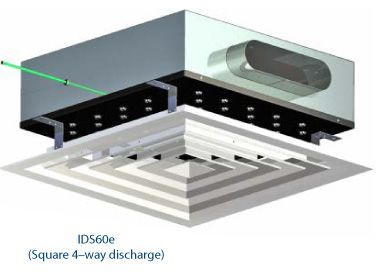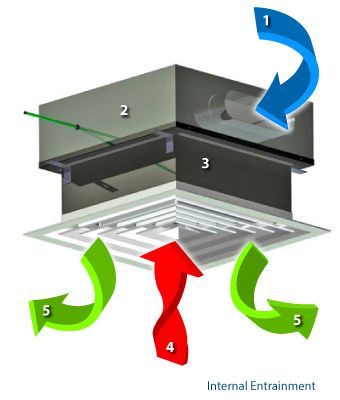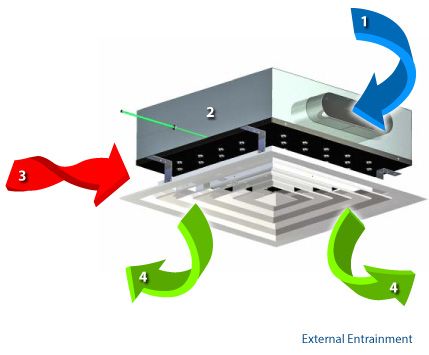DADANCO EUROPE’s Inffuser, when used with low primary supply air temperatures, offers an opportunity to improve both the energy efficiency and comfort level of variable air volume systems, as well as in other conventional HVAC system types, with minimal changes to the existing infrastructure.
INFFUSERs increase the amount of air being delivered to the room by utilizing DADANCO EUROPE’s special nozzle technology to induce secondary air into the Inffuser, where it is mixed with the primary air, before being discharged into the space.
Benefits
DADANCO EUROPE INFFUSERs offer an opportunity to improve both the energy efficiency and control level of VAV syatems, as well as in other conventional HVAC systems in many market sectors including Schools and Universities, Healthcare and Hospitals,Hotels, Laboratories, commercial offices, Government Institutional and Defense buildings, either for New build or Green renovation.
Why are INFFUSERs “Green”…
DADANCO EUROPE INFFUSERs offer an opportunity to improve both the energy efficiency and control level of VAV systems, as well as in other conventional HVAC systems in many market sectors including Schools, Universities, Healthcare and Hospitals, Hotels, Laboratories, commercial offices, Government Institutional and Defense buildings, either for new build or Green Renovation.
In an “all-air” system such as VAV, primary air is typically delivered to the room at 16ºC. Most designers, striving to reduce energy and save space, never consider the merits of using lower primary air temperature due to their concerns about achieving occupier comfort while delivering colder air.
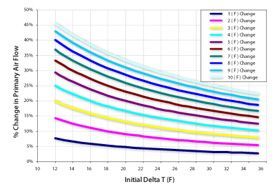 On a typical building (at sea level) with a space design temperature of 24ºC and primary air at 16ºC , for every kW of cooling needed, approximately 100L/s (360m3/h) of primary air has to be conditioned and delivered by the central plant. When the temperature is lowered by 6ºC to 10ºC, the air volume is reduced to 59 L/s (212 m3/h) (approximately 40% less to provide the same amount of sensible cooling). This graph shows the Percentage Change in Primary Air Flow when the air temperature is changed relative to the initial ΔT. When the biggest consumer of energy in the HVAC system is the primary air fan, any reduction in flow provides energy savings and lower operating costs. As lower primary air temperatures tend to be below the space dew point, concerns about condensation forming must be a consideration along with the diffusers’ ability to mix the colder air within the given throw distance in order to avoid drafts and, on VAV systems under part load conditions, the increased potential for the colder air to dump as the air volume decreases.
On a typical building (at sea level) with a space design temperature of 24ºC and primary air at 16ºC , for every kW of cooling needed, approximately 100L/s (360m3/h) of primary air has to be conditioned and delivered by the central plant. When the temperature is lowered by 6ºC to 10ºC, the air volume is reduced to 59 L/s (212 m3/h) (approximately 40% less to provide the same amount of sensible cooling). This graph shows the Percentage Change in Primary Air Flow when the air temperature is changed relative to the initial ΔT. When the biggest consumer of energy in the HVAC system is the primary air fan, any reduction in flow provides energy savings and lower operating costs. As lower primary air temperatures tend to be below the space dew point, concerns about condensation forming must be a consideration along with the diffusers’ ability to mix the colder air within the given throw distance in order to avoid drafts and, on VAV systems under part load conditions, the increased potential for the colder air to dump as the air volume decreases.
DADANCO EUROPE’s INFFUSERs use entrainment to temper the primary air and increase the volume delivered (typically 1–2 times the amount of primary & generally in the 60’s oF in cooling and 80’s oF in heating) meaning that the air is delivered above the dew point, is warmer and as a result, needs less mixing in the room to avoid drafts. Therefore, the possibility for dumping is dramatically reduced, and by correct selection, the condensation risk is eliminated. Even with 20% less air volume, the latent cooling capacity of the air at 50oF (95% RH) is over 2 times that of air at 55oF at the same RH, therefore lower primary air temperatures offer significantly better humidity control. So INFFUSERs are ‘Green’ because they allow you to save energy by reducing the primary air volume needed to cool the building, reducing the size of the central air handler and ductwork, saving operation cost. Laboratory tests were conducted at varying primary air temperatures and room humidity levels. These test results indicate that, with a room design temperature of 75oF, moisture did not form on the Inffuser faces using 46oF primary air until the room’s relative humidity reached 75%. With adequate latent cooling capacity being provided by the primary air, this condition will not occur.
Induction versus Aspiration…

The induction process is significantly different to aspiration. Aspiration occurs when room air mixes with the air being discharged from the terminal outlet, which occurs to a varying extent with all types of diffusers.
The amount of air being induced by the INFFUSERs can be closely controlled and measured by varying the number and size of nozzles within the unit. Induction, as opposed to aspiration, is the process of mixing primary and room air within the INFFUSER before the mixed (and tempered) air is discharged into the room.
The aspiration process relies on mixing the supply and room air within the room, in essence using the room as a mixing chamber.
High aspiration products such as swirl diffusers do not induce air from the room or ceiling return plenum into the product’s internal mixing chamber prior to discharging into the room, so when primary air is supplied at 48°F through one of these devices, you have to consider all the inherent issues of delivering low temperature air significantly below the room dew point into the room.
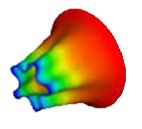
DADANCO EUROPE INFFUSERs utilize unique nozzle and fluid dynamics technology to provide very high air entrainment ratios at low pressure drops and superior performance at low noise levels.
Due to the fact that DADANCO EUROPE INFFUSERs are an induction device, airflow measurements should not be taken with an air capture hood. The only way to accurately measure the primary air flow into the INFFUSER is by reading the static pressure from the commissioning sampling tube from the INFFUSER plenum. A ‘primary air flow vs. static pressure’ chart is provided for each unit. Do not utilize static pressure readings in the duct near the INFFUSER inlet and presume it will be the same as that in the unit’s primary air plenum for commissioning purposes as this measurement could be significantly different from that measured through the commissioned sampling tube.
Common Applications
Common Applications…
Any air distribution system where an increase in the quantity of supply air delivered to the room at a more temperate temperature is of benefit such as those spaces that suffer from:
- Needing more cooling capacity delivered with existing infrastructure.
- Poor or inadequate air distribution.
- Dumping or draft issues under cooling.
- Stratification problems under heating.
Any air distribution system being designed to save energy or striving to achieve LEED certification and, therefore, the use of low temperature primary air (45-50oF), in order to reduce primary airflow volume by 20-30%, is of benefit such as in spaces where:
- There are building constraints that limit space available for the central air handling plant.
- There are building constraints that limit the space available for supply/return ductwork & terminal outlets.
- The zones have low to medium sensible cooling and heating load densities.
- The zone is running at, or near to, minimum fresh air requirements and tight humidity control is essential.
| Type | Application | Solution |
|---|---|---|
|
Existing Building |
Improve the energy performance of an existing VAV or CAV system. | Reduce primary air temperature and airflow rate leaving the cooling coil to maintain the cooling capacity required. Replace existing diffuses with INFFUSERs to temper the air being delivered to the conditioned space. |
| Air distribution/movement is inadequate and existing ductwork sizes are not large enough to permit supply air quantities to be increased. | Retain ductwork and replace existing diffusers with INFFUSERs to increase the supply air quantity and air movement being delivered to the conditioned space. | |
| Cooling capacity is inadequate and existing ductwork sizes are not large enough to permit supply air quantities to be increased. | Retain ductwork and reduce the primary air temperature for increased cooling capacity using INFFUSERs to temper the air being delivered to the conditioned space. | |
|
New Building |
Replacement of fan-powered VAV units to eliminate fan energy and VAV terminal maintenance considerations. | Replace fan-powered VAV units with single duct VAV terminals, retain ductwork, replace existing diffuses with INFFUSERs to temper the air being delivered to the conditioned space |
| LEED design where lower temperature primary air delivers benefits in fan energy savings and reduced system infrastructure. | Design the system for lower primary air temperatures and air quantities using INFFUSERs to temper the air and deliver higher air circulation rates to the space. | |
| Where internal zone loads are less than 15 Btu/h/sq.ft and good air circulation and humidity control is required. | Design the system with low temperature (48oF) primary air and flow rate of approximately 0.5 cfm/sq. using INFFUSERs to temper the air and deliver higher air circulation rates to the space. |
Product Range
Product Range
DADANCO EUROPE Inffuser™ designs have been developed using the patented nozzle technology. DADANCO EUROPE units can be provided to fit into a standard T-bar ceiling, dry wall/plaster ceilings and other ceiling types as required.
Our product range covers the following Inffuser styles and grille lengths:
- IDS Square 4-way discharge (2 x 2 feet).
- IDL Linear slot 1 or 2-way discharge. Nominal unit lengths of 2, 4 and 6 feet are available, or as a continuous slot.
All are available in internal and external entrainment configurations. Our INFFUSERs deliver superior Indoor Environment Quality (IEQ) and Air Change Effectiveness (ACE) in both perimeter and interior zones.







